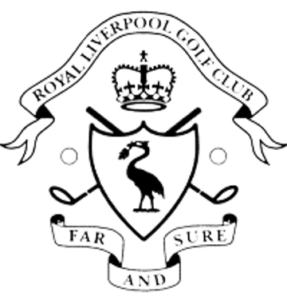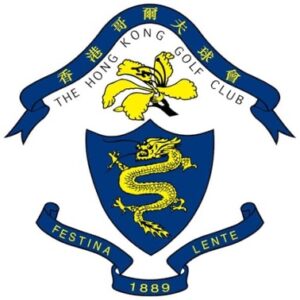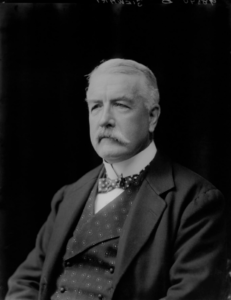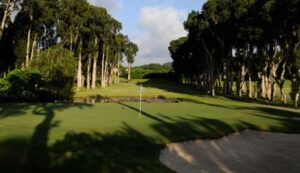In 1857, on the banks of the Inverclyde River on the west coast of Scotland, a young boy was born who would grow up to be pivotal in the spreading of the Royal and Ancient game of golf to Asia. His name was Gershom Stewart, and the son of Andrew and Margaret would prove pivotal in expanding the game Eastwards. After moving south to the Wirral Peninsula in England and becoming a member of the Royal Liverpool Golf Club at Hoylake, he would take up a role in the East India trade. In 1882, this employment took the young man to Hong Kong. Shortly after, and with a stroke of luck, he encountered the Royal and Sutherland Highlanders, a golfing battalion who had arrived from Ceylon with a desire to ‘keep swinging’. Stewart’s everlasting affinity with Hoylake can be seen in the parallel motifs between the two clubs’ crests.
In May 1889, Stewart, working at the time for the Hong Kong & Shanghai Bank, put out a public notice in the press of the desire to establish a golf club in Hong Kong. The day after, thirteen men gathered at the Hong Kong Club on Queen’s Road, a vote was held and the Club was born into existence.
The early golfing years of the Club were enjoyed, as with many other sporting societies in Hong Kong during this period, at the Racecourse at Happy Valley. The first ball was hit by James Lowson of Forfar, Scotland, in July 1890. A talented sportsman, Lowson enjoyed plenty of success in club competitions during the early years at Happy Valley. From the few photographs that survive from this period of the Club’s history, the Links, situated in the middle of the racecourse appears to have struggled from overcrowding. With only space for 9 holes, and with the land being shared for a number of different sports, the quality of the fairways and greens suffered. This was exacerbated by flooding issues and the building of a large pond which was designed and dug in as a relief mechanism. This resulted in a concerted effort from the Club to try and find a more suitable plot of golfing land.
Three years passed before a piece of land was found at Deep Water Bay and was designed and converted into a Par-30, 8 hole Links. It was a remarkable turnaround as competitions began to be held at the Bay course later that year in 1893. In 1897, a ‘grand plan’ came to fruition. The unassailable Gershom Stewart, with the help of his good friend Sir William Robinson, Governor of Hong Kong, requested as it was the year of Queen Victoria’s Diamond Jubilee, for Royal Charter. With celebrations all around the world, Royal Status was approved and 1897 marked the birth of The Royal Hong Kong Golf Club.
The Club would continue to grow in membership over the following years, with golfing life split between the Links at Happy Valley and at Deep Water Bay. In 1911, the Club looked once again outwards for greater space. Fanling Valley, much further north and close to the Chinese border was decided upon as a suitable location. With land carefully and meticulously allocated in the New Territories, getting approval for building a golf course was not an easy task. The Hon. Edwin Richard Halifax ‘an ally inside the Government’ proved to be a prize asset for the Club for his huge role in broking the deal which saw approval of the course’s building at Fanling in 1911. To this day, the Hong Kong Golf Club plays at both Deep Water Bay and Fanling.
In 1918, during the historic Racing Carnival, disaster struck, and a great fire broke out at the Happy Valley Racecourse. Very sadly many people lost their lives and the Golf Clubhouse was destroyed. To this day, the disaster of 1918 remains one of the toughest days in the Club’s history.
However, the clubhouses and buildings at Deep Water Bay and Fanling are of great interest. As golf clubhouses always are, these buildings became active hubs of social life, and home to stories of golfing successes, blunders, mysteries and tales. Learning more about club life, the personalities, customs and practices would be a tremendously interesting project to undertake. Historians of golf in Asia, and in British colonies more widely, have revealed that a far more ‘liberal’ attitude to female members was taken and indeed there is evidence of this in Hong Kong, too. A ladies Putting Club is known of as early as 1904 and any research into RHKGC’s history should endeavour to learn much more about this.5
- https://www.golfweather.com/golf-news/royal-liverpool-to-host-2022-open/2418 [↩]
- https://www.asiangolfconstruction.com/projects/hong-kong-golf-club/ [↩]
- https://www.npg.org.uk/collections/search/portrait/mw97786/Sir-Gershom-Stewart?LinkID=mp79714&role=sit&rNo=0 [↩]
- https://www.golfinhongkong.com/fanling-golf-club-new-course-review/ [↩]
- The Hong Kong Golf Club, Along the Fairways of History, (2014) [↩]



